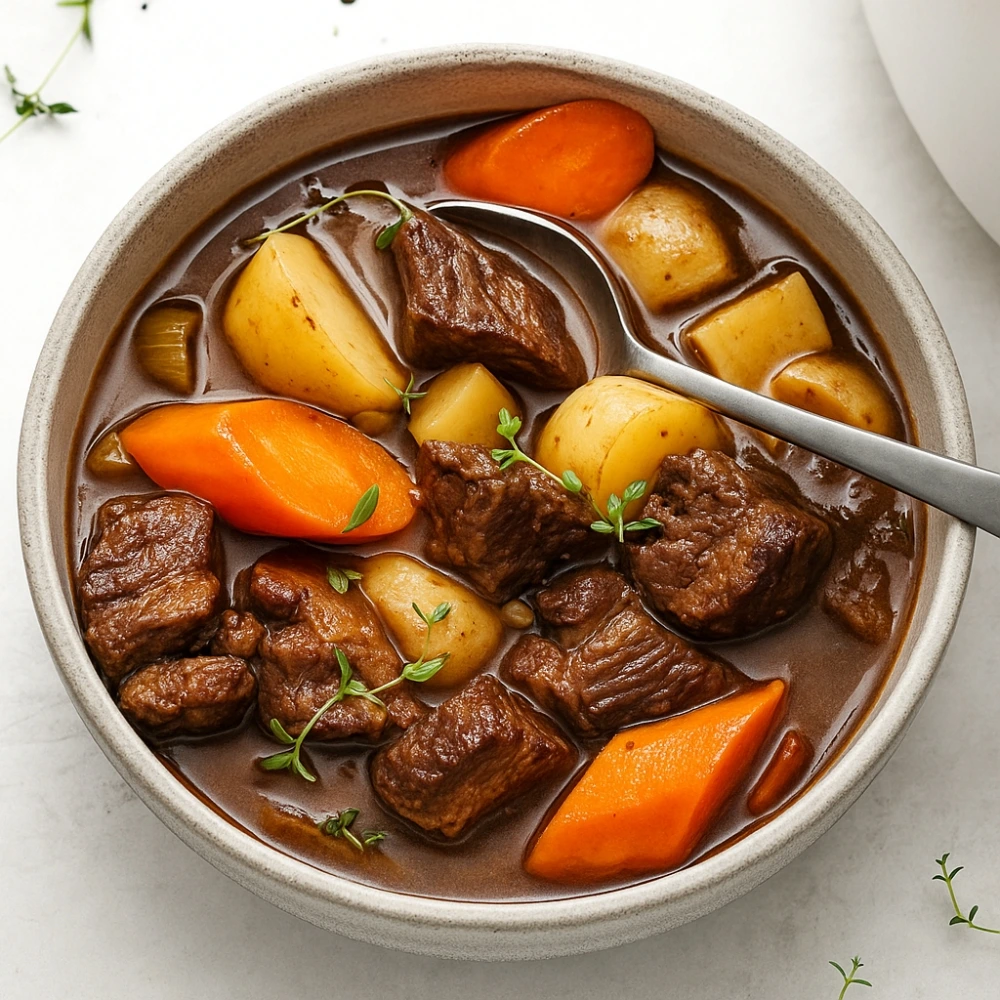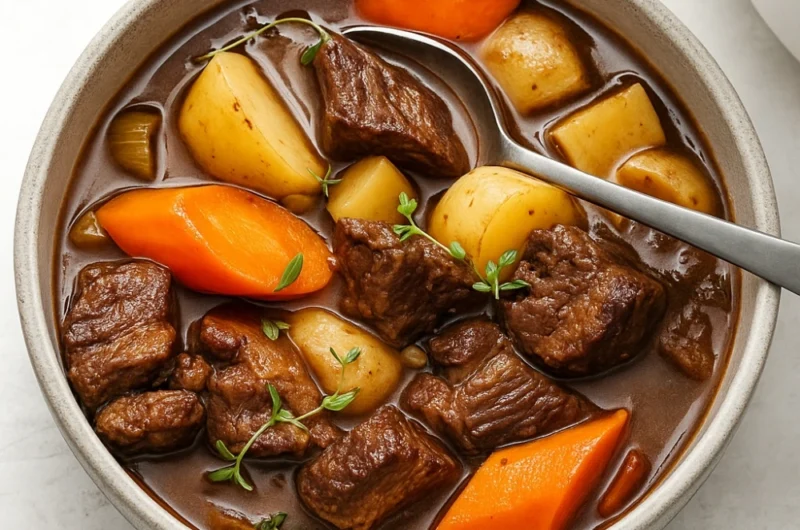The Best Fluffy Pancakes recipe you will fall in love with. Full of tips and tricks to help you make the best pancakes.
Beef Stew: Master the Perfect Comfort Food Classic

There’s nothing quite like a perfectly crafted beef stew to warm your soul on a chilly evening. This hearty, comforting dish has graced dinner tables for centuries, transforming humble ingredients into something extraordinary. Whether you’re a beginner cook or a seasoned chef, mastering the art of beef stew will elevate your culinary repertoire and create memories that last a lifetime.
In this comprehensive guide, we’ll explore everything from selecting the perfect cut of meat to troubleshooting common issues, ensuring your homemade beef stew becomes the gold standard in your kitchen. Get ready to discover the secrets behind creating tender, flavorful stew that rivals any restaurant or grandmother’s recipe.
The Gold Standard Beef Stew Recipe
Ingredients (Serves 6-8)
For the Beef:
- 3 lbs chuck roast, cut into 2-inch cubes
- 1/4 cup all-purpose flour
- 2 tsp kosher salt
- 1 tsp black pepper
- 3 tbsp vegetable oil
For the Stew:
- 1 large yellow onion, diced
- 4 cloves garlic, minced
- 2 tbsp tomato paste
- 1 cup red wine (Cabernet Sauvignon or Merlot)
- 4 cups beef broth
- 2 bay leaves
- 2 sprigs fresh thyme
- 1 sprig fresh rosemary
- 2 lbs Yukon Gold potatoes, cut into chunks
- 4 large carrots, cut into 2-inch pieces
- 3 celery stalks, chopped
- 2 tbsp Worcestershire sauce
- Salt and pepper to taste
Step-by-Step Instructions
Step 1: Prepare and Brown the Beef
Season the beef cubes with salt and pepper, then dredge in flour. Pro tip: This flour coating not only helps with browning but also naturally thickens your stew as it cooks.
Heat oil in a heavy-bottomed Dutch oven over medium-high heat. Brown the beef in batches, ensuring each piece develops a deep, golden crust. This Maillard reaction is crucial for flavor development—don’t rush this step! Each batch should take 3-4 minutes per side.
“The secret to exceptional beef stew lies in patience during the browning process. That beautiful crust translates directly to rich, complex flavors.” – Chef’s Note
Step 2: Build Your Flavor Base
Remove beef and set aside. In the same pot, sauté onions until translucent, about 5 minutes. Add garlic and tomato paste, cooking for another minute until fragrant.
Deglaze the pot with red wine, scraping up all those beautiful browned bits from the bottom. This technique captures every ounce of flavor that would otherwise be lost.
Step 3: The Slow Magic
Return beef to the pot along with beef broth, bay leaves, thyme, and rosemary. The liquid should just cover the meat. Bring to a gentle simmer, then reduce heat to low.
Cover and simmer for 1.5 hours, stirring occasionally. The beef should be fork-tender but not falling apart.
Step 4: Add Vegetables
Add potatoes, carrots, and celery to the pot. Continue simmering for another 30-45 minutes until vegetables are tender and the stew has thickened naturally.
Stir in Worcestershire sauce and season with salt and pepper to taste.
Recipe Variations for Every Kitchen
Slow Cooker Method
- Brown beef as directed above
- Transfer everything to slow cooker
- Cook on LOW for 7-8 hours or HIGH for 4-5 hours
- Add vegetables in the last 2-3 hours
Instant Pot Version
- Use sauté function to brown beef
- Add remaining ingredients
- Pressure cook HIGH for 35 minutes
- Natural release for 15 minutes
Dietary Adaptations
| Dietary Need | Modification |
|---|---|
| Gluten-Free | Replace flour with cornstarch slurry |
| Dairy-Free | Already dairy-free! |
| Paleo | Omit potatoes, add extra root vegetables |
| Low-Sodium | Use low-sodium broth, reduce salt |
Choosing the Perfect Beef Cut
Not all beef cuts are created equal for slow-cooked stews. Here’s your guide:
Best Cuts for Stew
- Chuck Roast: The gold standard with perfect marbling and connective tissue
- Bottom Round: Leaner but excellent flavor when cooked properly
- Short Ribs: Ultra-rich but requires longer cooking time
Preparation Tips
- Cut against the grain for maximum tenderness
- Trim excess fat but leave some for flavor
- Keep pieces uniform (2-inch cubes) for even cooking
Mastering the Technique
The Science of Simmering
The magic happens between 185-195°F (85-90°C). This gentle heat breaks down tough collagen into silky gelatin, creating that signature tender beef stew texture we all crave.
Key indicators of proper simmering:
- Occasional gentle bubbles breaking the surface
- Light steam rising from the pot
- No vigorous boiling (this toughens the meat)
Thickening Your Stew
Several methods achieve the perfect consistency:
- Flour dredging (our preferred method)
- Cornstarch slurry (2 tbsp cornstarch + 2 tbsp cold water)
- Mashed potato method (mash one cooked potato into the stew)
Troubleshooting Common Issues
“My beef is tough!”
- Solution: Continue cooking longer at lower heat
- Prevention: Choose well-marbled cuts, maintain proper simmering temperature
“My stew is too watery!”
- Quick fix: Mix 2 tbsp cornstarch with cold water, stir into simmering stew
- Next time: Less liquid or longer cooking time
“It tastes bland!”
- Boost flavor: Add more salt, Worcestershire sauce, or tomato paste
- Umami enhancers: Soy sauce, anchovy paste (just a tiny amount), or mushrooms

Frequently Asked Questions
Q: Can I make beef stew ahead of time? A: Absolutely! Beef stew actually improves after a day in the refrigerator as flavors meld together.
Q: What’s the best way to reheat leftover stew? A: Gentle stovetop reheating with a splash of broth works best. Avoid microwaving if possible.
Q: Can I freeze beef stew? A: Yes, for up to 3 months. However, potatoes may become grainy when frozen. Consider adding fresh potatoes when reheating.
Q: What should I serve with beef stew? A: Classic pairings include crusty bread, buttermilk biscuits, mashed potatoes, or egg noodles.
Elevating Your Beef Stew Game
Flavor Boosters
- Red wine reduction: Reduce 1/2 cup wine separately until syrupy, then stir in
- Fresh herbs finish: Add fresh parsley or chives just before serving
- Acid balance: A splash of red wine vinegar brightens the entire dish
Seasonal Variations
- Fall: Add parsnips, turnips, or butternut squash
- Winter: Include mushrooms for earthiness
- Spring: Fresh peas in the final 5 minutes of cooking
The Perfect Serving Experience
Present your masterpiece in warmed bowls, garnished with fresh herbs. The aroma alone will have your family gathering around the table before you can say “dinner’s ready.”
Remember, the best beef stew recipe is one that brings people together. Whether it’s a weeknight dinner or Sunday supper, this timeless dish creates connections and comfort that transcend the ordinary.
Your journey to beef stew mastery starts with quality ingredients, proper technique, and patience. Follow these guidelines, and you’ll create a stew worthy of any special occasion—or any regular Tuesday when you need a little extra comfort in your bowl.
Happy cooking, and may your kitchen always smell like home!
Beef Stew: Master the Perfect Comfort Food Classic
Course: Dinner, LunchCuisine: American6
servings20
minutes2
minutes450
kcalIngredients
2 lbs (900 g) beef chuck, cut into 1 ½-inch cubes
3 tbsp olive oil
1 large onion, chopped
3 garlic cloves, minced
4 carrots, sliced
3 celery stalks, sliced
3 potatoes, diced
2 tbsp tomato paste
4 cups beef broth
1 cup red wine (optional, can substitute with more broth)
2 bay leaves
1 tsp dried thyme
1 tsp dried rosemary
Salt and pepper, to taste
2 tbsp flour (for thickening)
Fresh parsley, chopped (for garnish)
Directions
- Brown the Beef: Heat olive oil in a large pot or Dutch oven. Season beef cubes with salt and pepper, then sear in batches until browned on all sides. Remove and set aside.
- Sauté Vegetables: In the same pot, add onion, garlic, carrots, and celery. Cook until softened (about 5 minutes).
- Add Tomato Paste & Flour: Stir in tomato paste and flour, cooking for 2 minutes to build flavor.
- Deglaze: Pour in red wine (if using) to deglaze the pan, scraping up browned bits.
- Simmer: Return beef to the pot. Add potatoes, broth, bay leaves, thyme, and rosemary. Bring to a boil, then reduce heat.
- Cook: Cover and simmer on low heat for about 2–2.5 hours, or until beef is tender and flavors meld together. Stir occasionally.
- Finish & Serve: Discard bay leaves, adjust seasoning with salt and pepper, and garnish with fresh parsley. Serve hot with bread or over rice.

